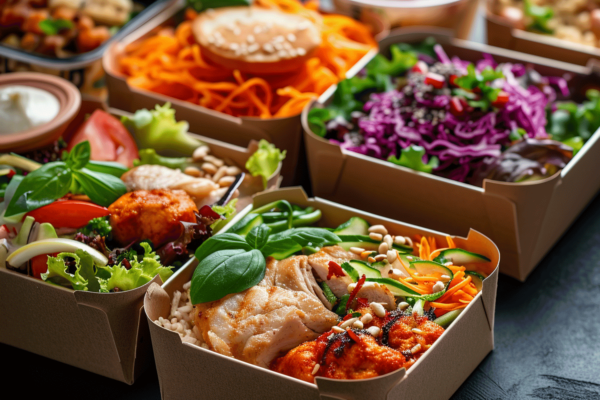According to Datassential’s Creative Concepts: Modern C-Stores report, 39% of consumers are interested in seeing meal kits at convenience stores.
Article originally published on SmartBrief.
Remember when it seemed like just about every health food featured labels calling out things like “only 90 calories!” or “low-fat”? While those labels do still exist, the meaning of health has evolved far beyond calorie counts.
Datassential first dove into health trends in 2016 with The New Healthy Keynote Report, and in the years since, new diets have come into play like ketogenic, propelling the need for an update. Our recently-released The New Healthy 2019 Keynote Report, or The New New Healthy, if you will, details the current landscape, tracking the evolution of health from 1.0 (low-fat, low-calorie foods) to 2.0 (feel-good foods denoted as natural and organic) to 3.0 (functional options such as superfoods) to 4.0 (personalized nutrition).
Just as consumers have pushed for customization in foodservice, choosing everything from bowl formats to burritos to the ingredients that go into each of those, consumers are now looking to custom diets, too, that fit their individual lifestyles. Here, we’re giving you a peek behind the curtain at today’s latest health and wellness insights gleaned from over 1,100 consumers and more than 300 operators. And just to drive home how vital food is to overall health, keep in mind that 9 out of 10 consumers say their diet increases their well-being (it falls just slightly below emotional/mental and physical health, but plays more of a role than finances and relationships).
Health gets personal
The title of this piece may make it seem like we’re spelling out what healthy means to consumers, but the truth is, with the growth of personalized nutrition, the definition of “healthy” can vary greatly among consumers. In fact, half of consumers say they agree with the statement that what might be healthy for some people may not be for others, and 9 in 10 say they think the idea of a personalized diet is a long-term trend, not a fad.
A variety of operators are capitalizing on the personalized eating trend with items that call out specialized diets such as keto or Whole30. Chipotle, for example, at the beginning of the year released a line of Lifestyle Bowls described as “helping those who have committed to living a healthier lifestyle by making it easy to order delicious bowls that contain only the real ingredients permitted by certain diet regimens.” That includes a Whole30 Salad Bowl with romaine, carnitas, fajita veggies, tomato salsa and guacamole, as well as a Paleo Salad Bowl, Keto Salad Bowl and Double Protein Bowl.
Customization, a hallmark of fast casuals like Chipotle, also goes hand-in-hand with personalization. That’s evidenced by the growth of build-your-own concepts, as the term “create your own” appears on 20% of menus and has increased 30% over the past 4 years, according to Datassential MenuTrends. While Chipotle offers specific diet-friendly dishes, operators looking to capitalize on the personalized eating trend don’t need to necessarily create new dishes from scratch – simply calling out that customization is possible or highlighting ingredient swaps for certain diets (such as menu language that says something like “sub coconut milk for a Paleo-friendly drink”) could help showcase the fact that an operator is capable of accommodating certain diets.
To take personalization one step further, there are also now a variety of companies touting what’s often referred to as DNA diets. Canada-based Nutrigenomix, for example, puts a spin on DNA testing (you know, all those ancestry commercials) by taking saliva samples from customers and in return sending personalized food and beverage recommendations based on an individual’s genetic makeup.
Changing consumer tastes
While plant-based everything seems to be exploding lately (did you see the news about KFC selling out of its limited-time vegan fried chicken in just five hours?), we dug deeper into consumers’ behaviors in our The New Healthy 2019 Keynote Report. Customers are indeed reporting more plant-forward eating habits – nearly 40% of people say they’re eating less red meat today compared to a year ago, while 49% say they’re eating more vegetables today. About a quarter of consumers are also saying they’d like to eat more superfoods, fruits and vegetables, but just haven’t been able to yet. But at the same time, operators who are jumping on the plant-based trend should note that most consumers aren’t actually interested in giving up meat completely (64% of consumers say they’re not interested in becoming vegetarians, while 70% say “nope” to eating a vegan diet).
Operators are certainly taking note of how the tide is turning for more healthy options as well – 30% of operators say they’ve noticed increased consumer demand for healthier items in the past year. But as consumers largely continue to eat a bit of everything, both manufacturers and operators could look for ways to sneak in some greens for those looking to add more to their diets, without alienating meat eaters. Prego, for instance, highlights that there’s “protein from vegetables” in two varieties of its Farmers’ Market sauces: The White Bean & Roasted Garlic and the Chickpea & Kale, both of which have vegetable protein from whole beans.
Renee Lee Wege is the publications manager at Datassential






